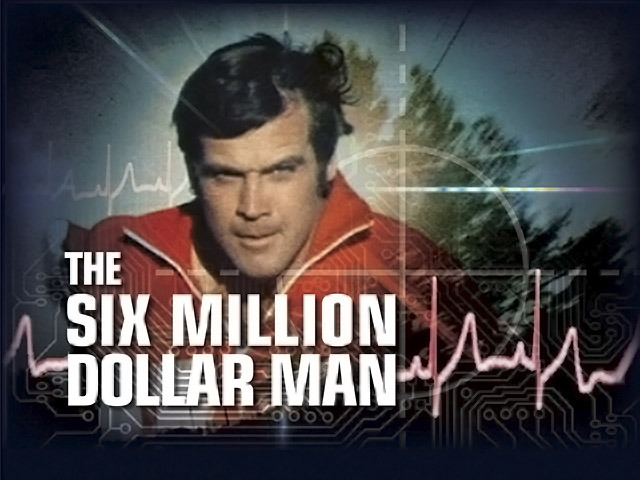Museum’s Final Friday aims to make you “better, stronger, faster” – Oct. 28
For immediate release ‐ October 14, 2016
Contact: Jon Pishney, 919.707.8083. Images available upon request

RALEIGH — How close is the singularity? Delve into the world of cyborgs, androids and biobots when the North Carolina Museum of Natural Sciences shows the 1973 TV movie “The Six Million Dollar Man” during Final Friday, October 28, 6-9 p.m. You will also discover the promise of biomedical engineering and the high-tech future of the human body with a presentation by professor Greg Sawicki.
“The Six Million Dollar Man” movie (and television series) stars Lee Majors as an astronaut/test pilot who is catastrophically mutilated in a test-plane crash, then rebuilt with nuclear-powered bionic limbs and implants so he can become a special operative for OSI, a covert government agency. The joint Department of Biomedical Engineering at North Carolina State University and the University of North Carolina at Chapel Hill stars Greg Sawicki, a professor and director of the Human PoWeR (Physiology of Wearable Robotics) Laboratory, which works to develop better lower-limb robotic devices to assist both healthy and impaired human locomotion.
Recently, Sawicki and his team have been working on (and receiving quite a bit of attention for) a carbon-fiber exoskeleton for the lower leg that provides assistance with walking. While the device is still a work in progress, early results are promising. Sawicki thinks the exoskeleton might eventually help those with battlefield injuries. “Because of improved medical care, wounded soldiers now are often able to keep their limbs, but in an impaired state,” he says. “The exoskeleton could take some of the workload from damaged areas.” The device could also help those who experience a stroke, which can leave patients with varying degrees of weakness.
Additionally, attendees of this month’s Final Friday can visit a science station highlighting research from the NC State Center for Additive Manufacturing and Logistics, including the use of 3D-printed implants and medical devices for companion animals and wildlife rehabilitation. Or meet the Cardinal Gibbons robotics team and the robots they have designed, built and programmed for entry in special competitions.
Final Fridays take place on the last Friday of each month. A/V Geeks’ Skip Elsheimer returns to provide a fun night of trivia and tongue-in-cheek commentary on not-so-mainstream movies as well as samples from his vault of 24,000 films. Movies will be complemented by experts and hands-on science stations related to each night’s theme. Dinner (such as sliders or tacos), drinks (including NC beer and wine) and popcorn will be available to buy before the show. Doors open at 5:30 p.m., movies and presentations begin at 7 p.m. Admission: $5/person. For more information, a list of future Final Fridays, or to buy tickets, visit naturalsciences.org/finalfridays.
The North Carolina Museum of Natural Sciences (11 W. Jones St. and 121 W. Jones St.) in downtown Raleigh is an active research institution that engages visitors of every age and stage of learning in the wonders of science and the natural world, drawing them into the intriguing fields of study that are critical to the future of North Carolina. Hours: Mon.- Sat., 9 a.m.-5 p.m., and Sun., noon-5 p.m. Visit the Museum online at www.naturalsciences.org. Emlyn Koster, PhD, Museum Director; Susan Kluttz, Secretary, N.C. Department of Natural and Cultural Resources; Pat McCrory, Governor.
The N.C. Department of Natural and Cultural Resources (NCDNCR) is the state agency with a vision to be the leader in using the state’s natural and cultural resources to build the social, cultural, educational and economic future of North Carolina. Led by Secretary Susan Kluttz, NCDNCR’s mission is to improve the quality of life in our state by creating opportunities to experience excellence in the arts, history, libraries and nature in North Carolina by stimulating learning, inspiring creativity, preserving the state’s history, conserving the state’s natural heritage, encouraging recreation and cultural tourism, and promoting economic development. NCDNCR includes 27 historic sites, seven history museums, two art museums, two science museums, three aquariums and Jennette’s Pier, 39 state parks and recreation areas, the N.C. Zoo, the nation’s first state-supported Symphony Orchestra, the State Library, the State Archives, the N.C. Arts Council, State Preservation Office and the Office of State Archaeology, along with the Division of Land and Water Stewardship. For more information, please call (919) 807-7300 or visit www.ncdcr.gov.

